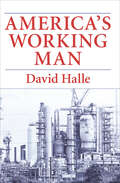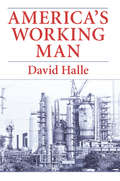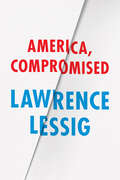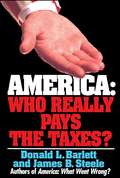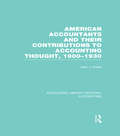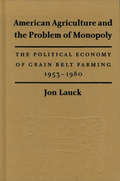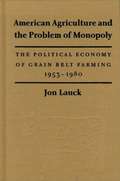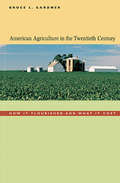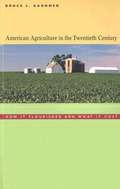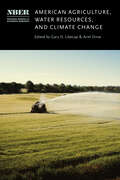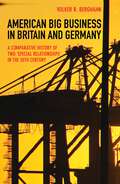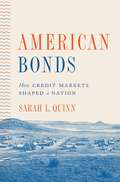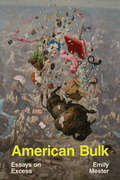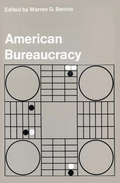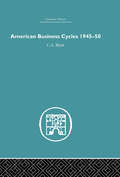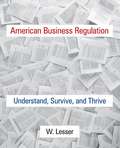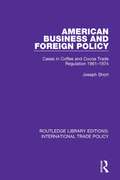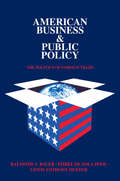- Table View
- List View
America's Uninsured Crisis: Consequences for Health and Health Care
by Institute of MedicineWhen policy makers and researchers consider potential solutions to the crisis of uninsurance in the United States, the question of whether health insurance matters to health is often an issue. This question is far more than an academic concern. It is crucial that U.S. health care policy be informed with current and valid evidence on the consequences of uninsurance for health care and health outcomes, especially for the 45.7 million individuals without health insurance. From 2001 to 2004, the Institute of Medicine (IOM) issued six reports, which concluded that being uninsured was hazardous to people's health and recommended that the nation move quickly to implement a strategy to achieve health insurance coverage for all. The goal of this book is to inform the health reform policy debate--in 2009--with an up-to-date assessment of the research evidence. This report addresses three key questions: What are the dynamics driving downward trends in health insurance coverage? Is being uninsured harmful to the health of children and adults?Are insured people affected by high rates of uninsurance in their communities?
America's Working Man: Work, Home, and Politics Among Blue Collar Property Owners
by David Halle&“An unusually deep and wide-ranging study&” by a sociologist who spent years listening to and living among workers at a New Jersey chemical plant (Journal of American Studies). Over a period of six years during the late 1970s, at factory and warehouse, at the tavern across the road, in their homes and union meetings, on fishing trips and social outings, David Halle talked and listened to workers of an automated chemical plant in New Jersey&’s industrial heartland—white, male, and mostly Catholic. He has emerged with an unusually comprehensive and convincingly realistic picture of blue-collar life in America during this era. Throughout the book, Halle illustrates his analysis with excerpts of workers&’ views on everything from strikes, class consciousness, politics, job security, and toxic chemicals to marriage, betting on horses, God, home-ownership, drinking, adultery, the Super Bowl, and life after death. Halle challenges the stereotypes of the blue-collar mentality and provides a detailed, in-depth portrait of one community of workers at a time when it was relatively affluent and secure. &“Absorbing reading.&”—Business Week
America's Working Man: Work, Home, and Politics among Blue-Collar Property Owners
by David HalleOver a period of six years, at factory and warehouse, at the tavern across the road, in their homes and union meetings, on fishing trips and social outings, David Halle talked and listened to workers of an automated chemical plant in New Jersey's industrial heartland. He has emerged with an unusually comprehensive and convincingly realistic picture of blue-collar life in America. Throughout the book, Halle illustrates his analysis with excerpts of workers' views on everything from strikes, class consciousness, politics, job security, and toxic chemicals to marriage, betting on horses, God, home-ownership, drinking, adultery, the Super Bowl, and life after death. Halle challenges the stereotypes of the blue-collar mentality and argues that to understand American class consciousness we must shift our focus from the "working class" to be the "working man. "
America, Compromised: Five Studies In Institutional Corruption (Berlin Family Lectures)
by Lawrence Lessig“There is not a single American awake to the world who is comfortable with the way things are.” So begins Lawrence Lessig's sweeping indictment of contemporary American institutions and the corruption that besets them. We can all see it—from the selling of Congress to special interests to the corporate capture of the academy. Something is wrong. It’s getting worse. And it’s our fault. What Lessig shows, brilliantly and persuasively, is that we can’t blame the problems of contemporary American life on bad people, as our discourse all too often tends to do. Rather, he explains, “We have allowed core institutions of America’s economic, social, and political life to become corrupted. Not by evil souls, but by good souls. Not through crime, but through compromise.” Every one of us, every day, making the modest compromises that seem necessary to keep moving along, is contributing to the rot at the core of American civic life. Through case studies of Congress, finance, the academy, the media, and the law, Lessig shows how institutions are drawn away from higher purposes and toward money, power, quick rewards—the first steps to corruption. Lessig knows that a charge so broad should not be levied lightly, and that our instinct will be to resist it. So he brings copious, damning detail gleaned from years of research, building a case that is all but incontrovertible: America is on the wrong path. If we don’t acknowledge our own part in that, and act now to change it, we will hand our children a less perfect union than we were given. It will be a long struggle. This book represents the first steps.
America: Who Really Pays the Taxes?
by Donald L. BarlettAmerica: Who Really Pays the Taxes? is a disturbing, eye-opening look at a tax system gone out of control. Originally designed to spread the cost of government fairly, our tax code has turned into a gold mine of loopholes and giveaways manipulated by the influential and wealthy for their own benefit.
American Accountants and Their Contributions to Accounting Thought: 1900-1930 (Routledge Library Editions: Accounting)
by John J. KahleAccounting carries with its history a vast number of ideas which have slowly developed along with it. This volume relates this history as it took place during the first three decades of the twentieth century in the United States. In particular it deals with those individuals who were for the most part responsible for it. It was these pioneers who recorded their observations of the actual workings of the myriad adaptations and new devices which had slowly eased their way into accounting theory and practice in the USA in the early twentieth century.
American Agriculture and the Problem of Monopoly: The Political Economy of Grain Belt Farming, 1953-1980
by Jon K. LauckThe breathtaking number of mergers and joint ventures among agribusiness firms has left independent American farmers facing the power of an increasingly concentrated buying sector. The origin of farmers’ concern with such economic concentration dates back to protests against meatpackers and railroads in the late nineteenth century. Jon Lauck examines the dimensions of this problem in the American Midwest in the decades following World War II. He analyzes the nature of competition within meat-packing and grain markets. In addition, he addresses concerns about corporate entry into production agriculture and the potential displacement of a production system defined by independent family farms. Lauck also considers the ability of farmers to organize in order to counter the market power of large-scale agribusiness buyers. He explores the use of farmer cooperatives and other mechanisms which may increase the bargaining power of farmers. The book offers the first serious historical examination of the National Farmers Organization, which fully embraced the bargaining power cause in the postwar period. Lauck finds that independent farmers’ attempts at organization have been more successful than previously recognized, but he also shows that their successes have been undermined by the growing concentration and power of agri-business firms, justifying a new approach to antitrust law in agricultural markets.
American Agriculture and the Problem of Monopoly: The political economy of grain belt farming, 1953-1980
by Jon LauckThe breathtaking number of mergers and joint ventures among agribusiness firms has left independent American farmers facing the power of an increasingly concentrated buying sector. The origin of farmers’ concern with such economic concentration dates back to protests against meatpackers and railroads in the late nineteenth century. Jon Lauck examines the dimensions of this problem in the American Midwest in the decades following World War II. He analyzes the nature of competition within meat-packing and grain markets. In addition, he addresses concerns about corporate entry into production agriculture and the potential displacement of a production system defined by independent family farms. Lauck also considers the ability of farmers to organize in order to counter the market power of large-scale agribusiness buyers. He explores the use of farmer cooperatives and other mechanisms which may increase the bargaining power of farmers. The book offers the first serious historical examination of the National Farmers Organization, which fully embraced the bargaining power cause in the postwar period. Lauck finds that independent farmers’ attempts at organization have been more successful than previously recognized, but he also shows that their successes have been undermined by the growing concentration and power of agri-business firms, justifying a new approach to antitrust law in agricultural markets.
American Agriculture in the Twentieth Century: How It Flourished and What It Cost
by Bruce L. GardnerAmerican agriculture in the twentieth century has given the world one of its great success stories, a paradigm of productivity and plenty. Yet the story has its dark side, from the plight of the Okies in the 1930s to the farm crisis of the 1980s to today's concerns about low crop prices and the impact of biotechnology. Looking at U.S. farming over the past century, Bruce Gardner searches out explanations for both the remarkable progress and the persistent social problems that have marked the history of American agriculture. Gardner documents both the economic difficulties that have confronted farmers and the technological and economic transformations that have lifted them from relative poverty to economic parity with the nonfarm population. He provides a detailed analysis of the causes of these trends, with emphasis on the role of government action. He reviews how commodity support programs, driven by interest-group politics, have spent hundreds of billions of dollars to little purpose. Nonetheless, Gardner concludes that by reconciling competing economic interests while fostering productivity growth and economic integration of the farm and nonfarm economies, the overall twentieth-century role of government in American agriculture is fairly viewed as a triumph of democracy.
American Agriculture in theTwentieth Century: How It Flourished and What It Cost
by Bruce L. GardnerAmerican agriculture in the twentieth century has given the world one of its great success stories, a paradigm of productivity and plenty. Yet the story has its dark side, from the plight of the Okies in the 1930s to the farm crisis of the 1980s to today's concerns about low crop prices and the impact of biotechnology. Looking at U. S. farming over the past century, Bruce Gardner searches out explanations for both the remarkable progress and the persistent social problems that have marked the history of American agriculture. Gardner documents both the economic difficulties that have confronted farmers and the technological and economic transformations that have lifted them from relative poverty to economic parity with the nonfarm population. He provides a detailed analysis of the causes of these trends, with emphasis on the role of government action. He reviews how commodity support programs, driven by interest-group politics, have spent hundreds of billions of dollars to little purpose. Nonetheless, Gardner concludes that by reconciling competing economic interests while fostering productivity growth and economic integration of the farm and nonfarm economies, the overall twentieth-century role of government in American agriculture is fairly viewed as a triumph of democracy.
American Agriculture, Water Resources, and Climate Change (National Bureau of Economic Research Conference Report)
by Gary D. Libecap and and Ariel DinarA collection of the most advanced and authoritative agricultural-economic research in the face of increasing water scarcity. Agriculture has been critical in the development of the American economy. Except in parts of the western United States, water access has not been a critical constraint on agricultural productivity, but with climate change, this may no longer be the case. This volume highlights new research on the interconnections between American agriculture, water resources, and climate change. It examines climatic and geologic factors that affect the agricultural sector and highlights historical and contemporary farmer responses to varying conditions and water availability. It identifies the potential effects of climate change on water supplies, access, agricultural practices, and profitability, and analyzes technological, agronomic, management, and institutional adjustments. Adaptations such as new crops, production practices, irrigation technologies, water conveyance infrastructure, fertilizer application, and increased use of groundwater can generate both social benefits and social costs, which may be internalized with various institutional innovations. Drawing on both historical and present experiences, this volume provides valuable insights into the economics of water supply in American agriculture as climate change unfolds.
American Airlines in 2011
by Willy ShihThe American Airlines in 2011 case was developed to provide a setting for the comparative analysis of two very different business models in the U.S. domestic airline industry-the network carrier and the low cost carrier (LCC). These models offer very different value propositions. Firms allocate resources into distinctively different processes, and they earn returns using parallel but different profit models. Yet while most scholars view the LCC model as disruptive, the two different models have been able to co-exist for over forty years, albeit with substantial evolution. By unpacking how one of the major network carriers was able to evolve its model successfully for such a long time before industry structural changes necessitated a radical overhaul, the cases seek to give students insights into how the different business models were established, how competitive forces have driven their evolution, and the importance of constantly evolving and tuning a firm's model.
American Airlines' Value Pricing (A)
by Alvin J. Silk Steven C. MichaelIn April 1992, American Airlines launched "Value Pricing" -- a radical simplification of the complex pricing structure that had evolved over more than a decade following deregulation of the U.S. domestic airline industry. American expected that the new pricing structure would benefit consumers and restore profitability to both American and the industry as a whole. The critical issue raised is: Would American's bold initiative work?
American Airlines, Inc.: Revenue Management
by Adam Brandenburger Anirudh DhebarBegins with a description of the elements of post-deregulation competition in the commercial airline industry. This should facilitate a discussion of the use of quantitative methods to support a broad range of tactical and strategic airline decisions. The principal thrust of the case is on revenue management. First, there is a description of the principal pricing concepts, followed by two examples of pricing decisions facing American. Next, there is a discussion of the basic yield management concepts and comments on the challenges in their implementation. Finally, there is a brief write-up on the structure and future of the revenue management organization.
American Bar Association Guide to Wills and Estates, Fourth Edition
by American Bar AssociationThe American Bar Association Guide to Wills & Estates, Fourth Edition, is the user-friendly guide that contains everything you need to know about planning an estate and preparing a will. It is organized in easy-to-follow chapters with sidebars containing tips, checklists, and key information, encouraging you to begin the process quickly and easily.The ABA Guide to Wills & Estates will help you:* Determine what to put in an estate plan* Decide whether to prepare a will, trust, or living trust* Avoid or reduce estate taxes* Transfer property without a will with substitutes such as life insurance and joint tenancy* Understand the benefits of living gifts and life insurance, among many other topics The Fourth edition features new and updated topics, such as: * Life-threatening and chronic illnesses* Incorporating your religious beliefs into your estate plan * Assisted reproduction and its resulting estate planning implications* Civil unions and same-sex marriages* Elder abuse and care* Information about Roth IRAs in estate plans* The impact of digital assets on estate planning
American Barrick Resources Corp.: Managing Gold Price Risk
by Peter Tufano Jon D. SerbinManaging the risk of changing prices of gold is central to the business strategy of American Barrick Resources Corp., one of North America's largest and most successful gold-mining firms. The case contrasts this firm's hedging policies with those of its rivals that do not hedge and details the wide range of hedging products (gold loans, forwards, options, spot deferred contracts) used to manage price risk. In 1992 the management of American Barrick is pleasantly surprised by unexpected new gold finds, but this new production places demands on the firm's hedging program and tests the firm's commitment to hedging when prices of gold and of many hedging vehicles are unattractive.
American Big Business in Britain and Germany: A Comparative History of Two "Special Relationships" in the 20th Century
by Volker R. BerghahnWhile America's relationship with Britain has often been deemed unique, especially during the two world wars when Germany was a common enemy, the American business sector actually had a greater affinity with Germany for most of the twentieth century. American Big Business in Britain and Germany examines the triangular relationship between the American, British, and German business communities and how the special relationship that Britain believed it had with the United States was supplanted by one between America and Germany.Volker Berghahn begins with the pre-1914 period and moves through the 1920s, when American investments supported German reconstruction rather than British industry. The Nazi seizure of power in 1933 led to a reversal in German-American relations, forcing American corporations to consider cutting their losses or collaborating with a regime that was inexorably moving toward war. Although Britain hoped that the wartime economic alliance with the United States would continue after World War II, the American business community reconnected with West Germany to rebuild Europe’s economy. And while Britain thought they had established their special relationship with America once again in the 1980s and 90s, in actuality it was the Germans who, with American help, had acquired an informal economic empire on the European continent.American Big Business in Britain and Germany uncovers the surprising and differing relationships of the American business community with two major European trading partners from 1900 through the twentieth century.
American Bonds: How Credit Markets Shaped a Nation (Princeton Studies in American Politics: Historical, International, and Comparative Perspectives #164)
by Sarah L. QuinnHow the American government has long used financial credit programs to create economic opportunitiesFederal housing finance policy and mortgage-backed securities have gained widespread attention in recent years because of the 2008 financial crisis, but issues of government credit have been part of American life since the nation’s founding. From the 1780s, when a watershed national land credit policy was established, to the postwar foundations of our current housing finance system, American Bonds examines the evolution of securitization and federal credit programs. Sarah Quinn shows that since the Westward expansion, the U.S. government has used financial markets to manage America’s complex social divides, and politicians and officials across the political spectrum have turned to land sales, home ownership, and credit to provide economic opportunity without the appearance of market intervention or direct wealth redistribution.Highly technical systems, securitization, and credit programs have been fundamental to how Americans determined what they could and should owe one another. Over time, government officials embraced credit as a political tool that allowed them to navigate an increasingly complex and fractured political system, affirming the government’s role as a consequential and creative market participant. Neither intermittent nor marginal, credit programs supported the growth of powerful industries, from railroads and farms to housing and finance; have been used for disaster relief, foreign policy, and military efforts; and were promoters of amortized mortgages, lending abroad, venture capital investment, and mortgage securitization.Illuminating America’s market-heavy social policies, American Bonds illustrates how political institutions became involved in the nation’s lending practices.
American Bulk: Essays on Excess
by Emily MesterRaised with hoarding and compulsive shopping, Emily Mester is caught in between. What happens when consumption begins to consume you back? In a series of deeply personal essays, Mester explores how the things we buy, eat, amass, and discard become an intimate part of our lives. We guiltily watch Amazon boxes pile up on the porch, wade through endless reviews to find the perfect product, and crave the comforting indulgence of a chain restaurant. With humor and sharp intellect, Mester reflects on the joys and anxieties of Costco trips, how a seasonal stint at Ulta Beauty taught her the insidious art of the sale, and what it means to get “mall sad.” In a nuanced examination of diet culture and fatness, Mester recounts her teenage summer at fat camp and the unexpected liberation she finds there. Finally, she ventures to Storm Lake, Iowa, to reckon with her grandmother’s abandoned hoard, excavating the dysfunction that lies at the heart of her family’s obsession with stuff. American Bulk introduces readers to a striking new literary talent from the American heartland, one who dares to ask us to regard consumption not with guilt but with grace and empathy.
American Bureaucracy
by Warren G BennisLike it or not, contemporary man is man-in-bureaucracy. He spends the majority of his waking hours in a bureaucracy; establishes an identity and status in a bureaucracy; garners most of his satisfactions and disappointments in a bureaucracy; and, increasingly, he is what he does.Aside from the importance of understanding those institutions that shape our values, behavior, and experience, bureaucracy is a vital area for study because it reveals a wide range of social behavior in a compact and comprehensible way. The abstract and ephemeral problems of society at large are brought down to earth —made measurable, comprehensible and visible in the bureaucratic microcosm. Problems of power and influence, change and innovation, intergroup conflict, ambition and aspiration, self-realization versus participative democracy, technology versus humanism: all can be observed and analyzed in human organizations.This volume pinpoints the dilemma of present bureaucratic organizations: the conflict between the need to sustain innovation and bureaucratic drives toward rationality and stability. The essays it contains discuss specific human needs that bureaucracy must meet if it is to continue to attract talented people and takes a step into the future to analyze the kinds of organizations that may be expected to evolve as institutions seek more flexible use of human resources.
American Business Cycles 1945-50
by Conrad BlythAfter the end of the Second World War businessmen and economists throughout the world feared that the American postwar inflationary boom would end in a serious slump. The slump took a long time to come, and when it did appear in 1949 it was both mild and short lived. In its mildness and brevity it foreshadowed the American business recessions since that time and, indeed, may foreshadow the end of the business cycle as it has been known in the past. This book presents the first full-scale study of the 1948–49 recession in the United States, making it the focal point of a detailed, analytical account of American business fluctuations from the end of the Second World War until the beginning of the Korean War. The main part of the book is prefaced by a review of fluctuations from 1945 to 1967 and of the business cycle theory, which places the postwar events in perspective. Of special importance are the studies of the ending, in early 1948, of the period of re-stocking and re-equipment; of the impact of the changed farm situation in this deflationary atmosphere, and use of modern consumption theory to explain the changes in household spending after the war and during the recession. Dr. Blyth has drawn extensively upon the results of modern economic research, and has woven the econometric findings and the historical narrative together with a theoretical analysis. He conclusively rejects the theory that recent U.S. business cycles are the result of any largely self-perpetuating fluctuation in investment in stocks. Instead he draws attention to the persistent destabilizing roles of changes in defense expenditure and of changes in monetary policy-inventory investment performs the largely passive role of aggravating these changes. The book, first published in 1969, will be of value not only to specialists in business cycle studies, but to economists and others concerned with the problems of stability and growth in the international economy, as well as to economic historians.
American Business Regulation: Understand, Survive and Thrive
by William LesserWhile there are lengthy texts discussing the economics of why and how governments regulate business and apply antitrust, this book is unique in providing the details of current business regulation in many industries through lengthy examples the author develops with the use of cases, including Harvard Business School cases. Students are then guided to devise business strategies of introducing new products within the scope of regulation (known or unknown). While the economic theories of regulation are covered, the focus of this text is a "hands-on coping" with regulation and using regulation as a business strategy to deal with competitors. Online instructor's materials are also available for adopters.
American Business and Foreign Policy: Cases in Coffee and Cocoa Trade Regulation 1961-1974 (Routledge Library Editions: International Trade Policy #1)
by Joseph ShortDeveloping countries have for many decades waged a campaign for the global regulation of trade in primary products through international commodity agreements. Heavily dependent upon exports of primary products, developing countries hope to regulate the markets for their commodities to achieve higher prices. While there is a myriad of obstacles to agreements, the blame for slow progress is often laid at the feet of the industrial, commodity-consuming countries, particularly the US. This book, first published in 1987, is a comparative case study that closely analyses how American businesses behaved in relation to US government responses to developing countries’ demands for commodity agreements for coffee and cocoa.
American Business and Public Policy: The politics of foreign trade
by Theodore DraperAmerican Business and Public Policy is a study of the politics of foreign trade. It challenges fifty years of writ-ing on pressure politics. It includes nine hundred interviews with heads of corporations, including 166 of the 200 largest corporations; another 500 interviews with congressmen, lob-byists, journalists, and opinion leaders; and eight community studies making this book the most intensive survey in print of the politics of business. It is a realistic behavioral examination of a major type of economic decision.The authors introduce their study with a history of the tariff as a political issue in American politics and a history of American tariff legislation in the years from Europe's trade recovery under the Marshall Plan to the challenge of the Common Market. They examine in succession the changing attitudes of the general public and the political actions of the business community, the lobbies, and Congress.American Business and Public Policy is a contribution to social theory in several of its branches. It is a contribution to understanding the business community, to the social psychol-ogy of communication and attitude change, to the study of political behavior in foreign policy.American Business and Public Policy is at once a study of a classic issue in American politics the tariff; decision-making, particularly the relation of economic to social-psycho-logical theories of behavior; business communication what businessmen read about world affairs, what effect foreign travel has on them, where they turn for political advice, and how they seek political help; pressure politics, lobbying, and the Congressional process.

